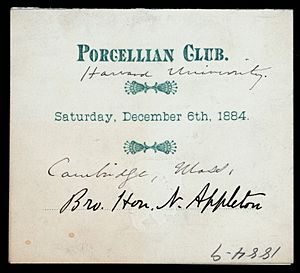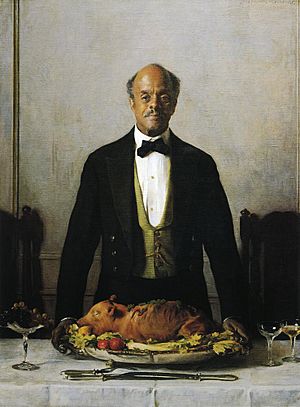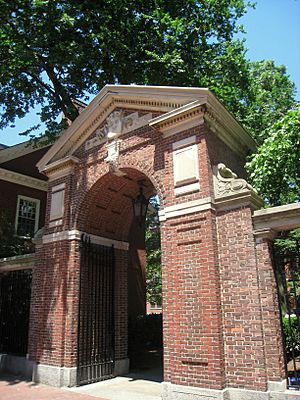Porcellian Club facts for kids
|
Porcellian Club
|
|
|
U.S. Historic district
Contributing property |
|
 |
|
| Location | 1320-24 Massachusetts Ave. Cambridge, Massachusetts |
|---|---|
| Part of | Harvard Square Historic District (ID86003654) |
| MPS | Cambridge MRA |
| NRHP reference No. | 83000824 |
Quick facts for kids Significant dates |
|
| Added to NRHP | June 30, 1983 |
| Designated CP | July 28, 1988 |
The Porcellian Club is a very old and exclusive club for male students at Harvard University. People sometimes call it the Porc or the P.C. It was founded around 1791 or 1794. At first, it was known as "the Argonauts" or "the Pig Club."
The club's motto is Dum vivimus vivamus, which means "while we live, let us live." This idea is about enjoying life. The club's symbol is a pig, and some members even wear golden pig charms or ties with pig heads on them. The Porcellian is known as one of the most exclusive clubs at Harvard.
Template:TOC limit=3
Contents
How the Club Started
The Porcellian Club began in 1791. It had rooms on Harvard Street and a library with about 7,000 books. Members were chosen from the senior, junior, and sophomore classes. Usually, about eight students from each class joined.
The club's name comes from a funny story. In 1791, a student had a pig in his room. He would make the pig squeal to bother a teacher who lived below him. When the teacher came to check, the student would hide the pig.
One day, the student heard his room would be searched. So, he invited friends, cooked the pig, and they all had a big feast. They enjoyed it so much that they decided to form a club. They wanted to have similar gatherings regularly. To remember this event and add a classic touch, they named it "Porcellian," from the Latin word "porcus," meaning pig.
In 1831, another group called the "Order of the Knights of the Square Table" joined the Porcellian. This happened because both clubs had the same goals.
The Clubhouse
The Porcellian clubhouse is located at 1324 Massachusetts Avenue. It sits above a clothing store. The building was designed by William York Peters, who was also a club member. The entrance faces the Harvard freshman dorms and the "Porcellian Gate" of Harvard Yard. This gate was given by the club in 1901. It has a stone carving of a boar's head.
Only members are usually allowed inside the clubhouse. However, non-members can enter the first-floor room called the Bicycle Room. Wives of members are allowed on their wedding day and during the member's 25th reunion. For example, Theodore Roosevelt once brought his first wife, Alice Hathaway Lee Roosevelt, to eat lunch at the club when they were students.
Some people, like writer Jeffrey Hart, have noted that the club's physical space is quite simple. He described it as just a large room above stores with a bar and a billiards table. There's also a mirror that lets members see outside without being seen.
A painting of George Washington Lewis, called The Steward, hangs in the clubhouse. He was the club's steward for over 45 years. He was highly respected by the members.
Inside the Clubhouse
An article from 1891 described the new clubhouse. The club needed more space because its library grew and more older members joined. In 1881, they decided to build a new building where their old one stood.
The new building is made of brick with stone decorations. It has four stories. Two large stores are on the ground floor. The club uses the three upper floors. The first club floor has a large hall and two reception rooms. These rooms connect to the library, which runs from the front to the back of the building.
On the second floor, there is a billiard hall at the front and a breakfast room at the back. The kitchen is above the main hall. Most of the top floor is a large banquet hall with beautiful vaulted ceilings.
Club's Importance in History
Many important people have been part of the Porcellian Club. For example, US President Theodore Roosevelt was a member. However, his distant cousin, Franklin D. Roosevelt (who also became a US President), was not invited to join. Franklin D. Roosevelt joined another club instead. Some say he later called not joining the Porcellian "the greatest disappointment in his life."
Another famous person, Joseph P. Kennedy Sr., also did not receive an invitation. A writer noted that he remembered this for years. He realized that no Catholic students he knew at Harvard had been chosen for the club.
In 1870, a travel book mentioned the Porcellian Club. It said that almost every student wanted to join. The club's activities were kept secret. The book suggested that the club offered enjoyable experiences without bad consequences.
The club's importance in Boston society is clear from the story of Henry Hobson Richardson, a famous architect. When he was chosen to design Trinity Church, it was noted that his membership in the Porcellian Club helped. This was because the church's rector and five committee members were also Porcellian members.
Who Can Join?
Historically, joining the Porcellian Club was very difficult for some groups. For example, a biography of Norman Mailer said it would have been "unthinkable" for a Jewish student to be invited when he was at Harvard.
However, things have changed over time. By 1986, some presidents of Harvard's exclusive clubs were Jewish, and one was Black. The Porcellian Club started to accept Jewish members. In 1983, it even admitted an African-American student, which surprised some older members.
A 1994 article in Harvard Crimson noted that while a student's background, region, and family history used to be the main factors for joining, they are not the only ones anymore. But they still play a role.
As of 2016, the club only admits male members. The club believes in the value of single-gender groups for men and women. They see these groups as a good option alongside mixed-gender institutions.
Joseph McKean Gate
In 1901, a gate was built at the entrance to Harvard Yard. It is directly across from the Porcellian clubhouse. According to a notice from 1909, this gate was put up by members of the Porcellian Club.
It honors Joseph McKean, who graduated in 1794. He was a professor at Harvard and is also known as the founder of the Porcellian Club. The gate clearly shows the club's symbol, a boar's head, above its main arch. It is a well-known landmark at Harvard.
Famous Members
Many notable people have been members of the Porcellian Club throughout its history. Here are some of them:
- Joseph Alsop (1932) – A journalist and author.
- August Belmont Jr. (1875) – A financier, known for Belmont Park and the Belmont Stakes horse race.
- Charles E. Bohlen (1927) – A diplomat and expert on the Soviet Union.
- William Astor Chanler (1895) – A soldier, explorer, and US congressman.
- John Jay Chapman (1884) – An author and translator.
- Justice Benjamin Robbins Curtis (1829) – A US Supreme Court Justice.
- Richard Henry Dana Jr. – Author of Two Years Before the Mast.
- Edward Everett – A US Secretary of State, Harvard president, and governor of Massachusetts.
- Hamilton Fish III (1910) – A college football player and congressman.
- Miles Fisher – An American actor.
- Oliver Wendell Holmes, Sr. – An author, poet, and professor.
- Justice Oliver Wendell Holmes, Jr. – A US Supreme Court Justice.
- William Henry Fitzhugh Lee (1858) – Son of Robert E. Lee, a Confederate general.
- Henry Cabot Lodge – An American statesman, congressman, and senator.
- Dan Sullivan – A US senator from Alaska.
- James Russell Lowell – A famous poet.
- Theodore Lyman III (1858) – A Union officer and congressman.
- George Meade (1866) – A major general in the United States Army, commander at Gettysburg. (Honorary member)
- Paul Nitze – A presidential advisor, diplomat, and foreign policy expert.
- Wendell Phillips – A leading abolitionist.
- William Phillips – A diplomat and US ambassador.
- Henry Hobson Richardson – A famous architect.
- President Theodore Roosevelt – The 26th president of the United States.
- Brigadier General Theodore Roosevelt, Jr. – A Medal of Honor recipient.
- Leverett Saltonstall – A US senator and governor of Massachusetts.
- Louis Agassiz Shaw II – A Boston socialite.
- Robert Gould Shaw (1856–1859) – A colonel who led the first all-volunteer Black regiment in the Union Army during the Civil War.
- Justice Joseph Story (1795) – A US Supreme Court Justice.
- Charles Sumner (1830) – A congressman and senator, and a leading abolitionist.
- Benjamin Ogle Tayloe (1814) – An American businessman and diplomat.
- Edward Thornton Tayloe – A diplomat and planter.
- Henry C. Wayne (1834) – A Confederate officer.
- Cameron Winklevoss (2004) – An Olympic rower and entrepreneur.
- Tyler Winklevoss (2004) – An Olympic rower and entrepreneur, twin brother of Cameron.
- Grenville Lindall Winthrop (1864–1943) – An American art collector.
- Owen Wister (1882) – Author of the novel The Virginian.
Many of these members came from well-known families in Boston, with the same family names appearing over generations.
See also




